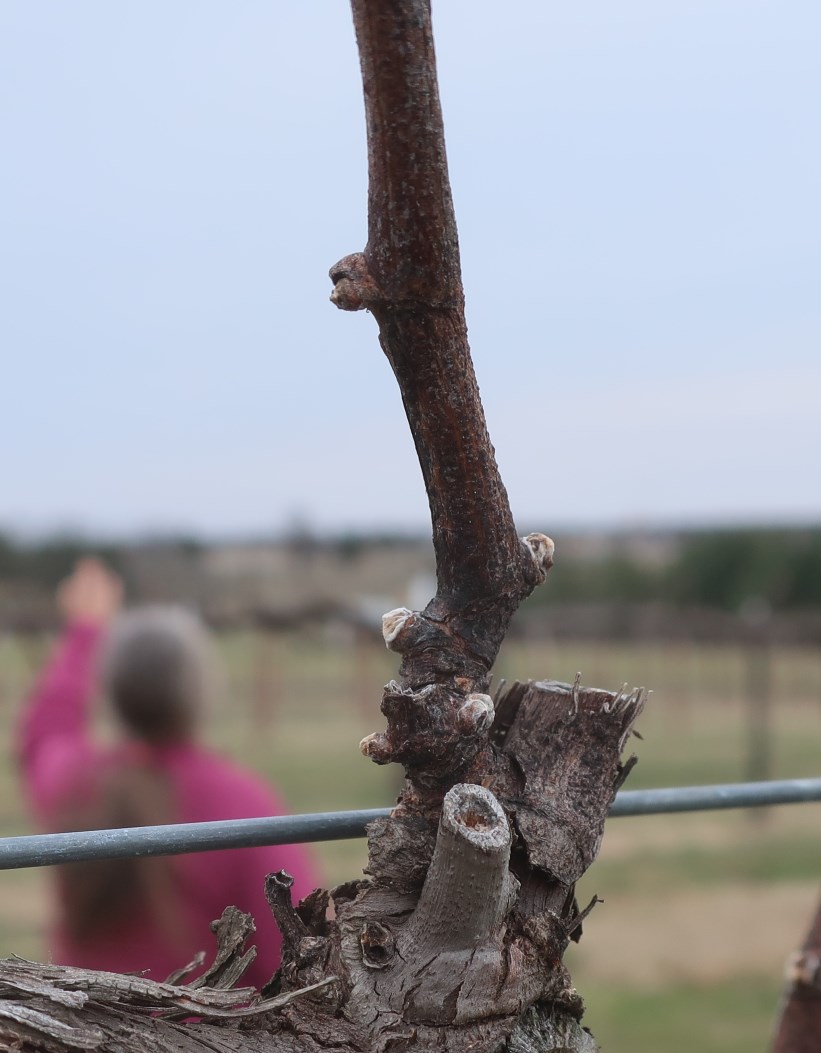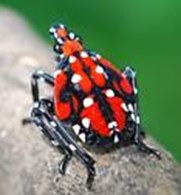Vinews
No. 1 — April 4, 2022
Contents:
- When Will Bud Break Occur?
- Pesticides Update
- Dormant and Delayed Dormant Sprays — Sulforix
- Early Cover Sprays — The First Cover Spray
- Spotted Lanternfly Updates
When Will Bud Break Occur?

Almost that time of year again when the grapevines start the annual cycle of growth (Figure 1). For many grape growers, they begin to watch the temperature forecasts more closely as grapevine buds begin to swell. As the grapevines progress from dormant/winter bud, bud scales opening, wooly bud, and finally, bud break, each of these stages are progressively more susceptible to frost/freeze events (Figure 2). Air temperatures below critical points can damage primary buds and sometimes even secondary buds. We know this all to well from the past two growing seasons. In 2020, air temperatures dipped below critical points on April 10 and 18. Similarly in 2021, air temperatures once again dipped below critical temperatures on April 21-23. In both of these years, frost/freeze damage occurred in Missouri, but damage was sporadic and depended on location. A common question arises from year to year, when will bud break occur?
You would think that with all the data accumulated that viticulturalists would be able to pinpoint when budbreak would start. A lot of people have tried to correlate bud break with air temperatures (degree days) over years. Research has tried to model these years based on degree days accumulated from Jan. 1 and April 1 of each growing season. In the end, there is very little correlation that provides any level of predicting bud break. Other research has tried to evaluate soil temperatures and the timing of bud break with, again, very little predictive ability.
A predictive model of bud break would provide the opportunity to implement some methods to potentially delay bud break. One method to delay bud break has been the application of oils prior to bud break. Although the oil applications have been effective in delaying bud break, the results have been mixed. Also the cost of oil applications is on the expensive side. The other method is to long prune. Long pruning involves leaving more buds on the spurs. This method relies on the physiology of the buds or apical dominance. The more distal buds will break bud prior to the basal buds as the distal buds maintain the apical dominance. In essence the distal or apical buds delay the development of the basal buds. Although long pruning can delay basal bud break, one of the drawbacks is the vines will need to be pruned twice, which can add considerable cost. Additionally, both of these methods are often overcome if air temperatures warm quickly and air temperatures are maintained for a long duration.
Are there other alternatives to maintaining count buds if a frost/freeze occurs in the spring? One method that has been implemented is to leave excess count buds when dormant pruning. The excess buds are like insurance should a spring frost/freeze event occur. If a frost/freeze event does not occur then something needs to be done to keep the grapevine balanced. To maintain vine balance shoot thinning or fruit thinning both may be considered.
Hopefully, this 2022 spring season the grapevines do not experience frost/freeze events as the grapevines progress from bud swell to bud burst and beyond.
Pesticides Update
- Ziram: Discontinued December 2022
- Alternative: Manacozeb containing products and Captan
- SporeQuell: Not available
- Alternative: Oxidate
- Lorsban Advanced (Chlorpyrifos): Banned by EPA
- Alternative products for mealybugs and scale insects: Applaud (Buprofezin), Sevin (Carbaryl) for controlling crawler stage of mealybugs, Movento (Spirotetramat) for mealybug and scale suppression. See Table 1 for more insecticides for managing mealybugs in grapes.
Recent vineyard surveys across Missouri resulted in finding only the grape mealybug Pseudococcus maritimus. Other research results help pinpoint the optimum time to apply control measures for the grape mealybug. For more information on the survey results and background information on mealybugs please see Jacob Corcoran's presentation at the 2022 Show Me Grape and Wine Conference and Symposium.
| Trade name | Chemical name | IRAC | Target pest | Efficacy1 |
|---|---|---|---|---|
| Applaud | Buprofezin | 16 | Mealybugs and Lecanium scale | ?2 |
| Imidan 70-W | phosmet | 1B | Grape mealybug | Fair |
| Tombstone | cyfluthrin | 3A | Grape mealybug | Good |
| Baythroid XL | beta-Cyfluthrin | 3A | Grape mealybug | Good |
| Assail 30G | acetamiprid | 4A | Grape, Obscure, and Vine mealybug |
Good |
| Belay | clothianidin | 4A | Grape, Long-tailed, Obscure and Vine mealybug |
Excellent |
| Scorpion 35SL | dinotefuran | 4A | Mealybug | Good |
| Wrangler | imidacloprid | 4A | Mealybug | Good |
| Swagger | imidacloprid + bifenthrin |
4A & 3A | Mealybug | Good |
| Leverage 360 | imidacloprid + beta-cyfluthrin |
4A & 3A | Mealybug | Good |
| Actara | thiamethoxam | 4A | Mealybug | Excellent |
| Platinum | thiamethoxam | 4A | Mealybug | Excellent |
| Voliam flexi | thiamethoxam + chlorantraniliprole |
4A & 28 | Mealybug | Excellent |
| Movento | spirotetramat | 23 | Mealybug | Excellent |
| Biocover MLT | mineral oil | NC | Mealybug | Good |
1Efficacy ratings based on VineSmith 2022 Winegrape Insecticide Guide. (vinesmith.com)
2No rating available.
Dormant and Delayed Dormant Sprays — Sulforix
Sulforix and other types of liquid lime-sulfur perform the best if applied in a short window prior to bud break. These sulfur compounds work by being caustic to fungal organisms. In essence, the sulfur compounds “burn-out” the cleistotheca of powdery mildew and other overwintering spores of some fungal diseases.
Be sure to read and follow the label of the product you are applying.
The Sulfortix label states:
“During the DORMANT/DELAYED DORMANT period PRIOR to BUD SWELL apply a single application...."
A couple of tips on application:
- Have nozzles positioned at cordons and trunk. Turn other nozzles off. Tower sprayers or over the top sprayers work best for application.
- Reduce air intake.
- Slow down your tractor speed.
- 20 to 30 gallons per acre should provide good coverage of the cordons.
- To be effective, the application needs to get into the cracks and crevices of the vine bark.
Spotted Lanternfly Updates
The Spotted Lanternfly continues to spread since first being discovered in Berks County, Pennsylvania in September of 2014. According to the USDA, Spotted Lanternfly has been reported in 11 states, including New Jersey, New York, Delaware, Maryland, Virginia, Connecticut, Massachusetts, Indiana, Ohio, and West Virginia. In September 2021, a single specimen of Spotted Lanternfly turned up at a Kansas State Fair as part of a participant's insect collection. The specimen was collected from a back porch in May and was reported to being very tattered. Further investigations in and around where the specimen was collected resulted in no more signs of Spotted Lanternflies. It is believed the single specimen potentially “hitchhiked” into Kansas via some type of vehicle such as an automobile or train car. Of more concern should be the report out of Indiana on July 27, 2021.
Spotted Lanternfly was reported from Vevay, Indiana, by a homeowner. Further investigation of the area discovered an infestation of Spotted Lanternfly in a wooded area. The town of Vevay is located in Switzerland County, Indiana, along the Ohio River. Switzerland County is located in the very southeast corner of Indiana. Vevay is 330 miles from St. Louis, Missouri, with Interstate Highway 64 being the most direct route. As Spotted Lanternfly continues to move westward, it is important that grape growers and the general public remain vigilant and report potential Spotted Lanternfly sightings.
The Spotted Lanternfly is a planthopper belonging to the order Hemiptera or true bugs. Other true bugs include cicadas, brown marmorated stink bugs, aphids and leafhoppers. A distinguishing feature of true bugs is a piercing-sucking mouthpart that allows them to pierce into a plants phloem and then withdraw the plant's sugary sap. This feeding results in the Spotted Lanternfly secreting honeydew which provides a substrate for sooty mold to grow. Damage to fruit crops from Spotted Lanternfly feeding can be twofold. A delay in sugar accumulation in the fruit as well as aesthetic damage from the formation of sooty mold on excreted honeydew.
Specific lifecycle characteristics of the Spotted Lanternfly allow for identification. Spotted Lanternfly have four nymphal stages, adult and an overwintering egg mass. There is one generation per year. The first three nymphal stages are black with white spots (Figure 3). The fourth nymphal stage is red with white spots and can attain a length of three-quarters-inch. The adults although often shown with wingspread are often encountered in the field with the wings folded.



These folded forewings wings are pinkish with approximately 2/3 of the length black spotted and the posterior of the forewings has a black-brick pattern. The egg masses are laid in approximately 1-inch segmented rows and in most instances, these seg-mented rows are covered with a grayish putty-like substance. The egg masses can be found on many hard surfaces both in nature and man-made.
What should you do if you suspect encountering Spotted Lanternfly? Take a photo, making sure the specimen is in focus. Collect a specimen. Send your photo to plantpest@mda.mo.gov
topEarly Cover Sprays — The First Cover Spray
After bud break the clock starts ticking and there is often a very small window to apply the first protective fungicide spray of the season. Often, the air temperatures are on the cool side and so the rush to apply a protective spray is often not given the priority it should. However, there are fungal diseases that are right at home with these cool air temperatures. Phomopsis viticola releases spores when air temperatures are as low as 41°F. If unprotected, green tissue is present and the tissue is wet, then Phomopsis is provided an opportunity to cause infection. However, at cooler air temperatures Phomopsis needs a longer period of wet tissue to result in infection compared to warmer temperatures. The cooler air temperatures delay the dry-down of green tissue compared to warmer air temperatures, thereby providing an infection period. Keep in mind that as tissue wetness duration increases so does the number of infections. As an example, at 50°F and 10 hours of tissue wetness, the number of lesions per leaf is approximately 10, whereas at 50°F and 20 hours of tissue wetness, the number of lesions per leaf is approximately 60.
Erincik, O., L.V. Madden, and M.A. Ellis. 2003. Temperature and Wetness-duration requirements for grape leaf and cane infection by Phomopsis viticola. Plant Disease 87:832-840.
topPlease scout your vineyards on a regularly scheduled basis in an effort to manage problem pests. This report contains information on scouting reports from specific locations and may not reflect pest problems in your vineyard. If you would like more information on IPM in grapes, please contact Dean Volenberg at 573-882-0476 or 573-473-0374 (mobile) or volenbergd@missouri.edu
top